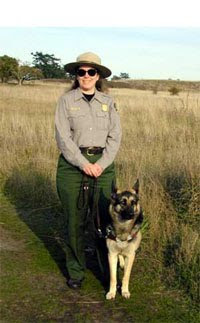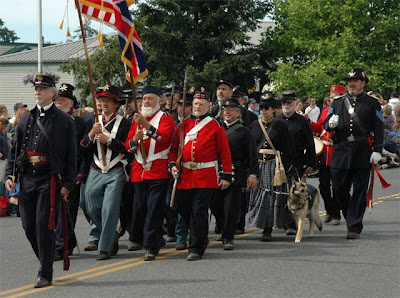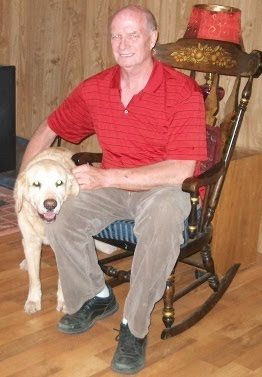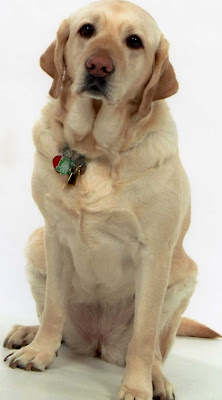by Deborah Armstrong
Nadia was an elegant black-and-tan shepherd who lead me everywhere on the U.C. Berkeley campus where I took classes in the early 1980s. Slender and low-slung, she glided up even the steepest hills leaving my college friends out of breath when they attempted to match our pace. She was my first guide, and having just reached drinking age myself my nights were full of partying and my days filled with not only studying but keeping up with three part-time jobs. The only time we were in the dorm was spent sleeping. We were a high-energy team who didn't always follow the rules.
In those days, GDB didn't train us on escalators, but I wanted to ride them, primarily because my rapid transit commute was difficult with only one remote stairway in the station. My girlfriend, Sheila had trained with her shepherd on escalators at The Seeing Eye (TSE), so I asked her to show me how it was done.
Leaving Nadia at home Sheila, her shepherd and I practiced using my cane as Juno until I got the knack of how one rides escalators The Seeing Eye way.
Then Sheila and I took
Nadia out to escalators where we practiced following her dog.
Nadia quickly picked up on the technique, which in those days involved jumping on and off the moving stairs to protect the dog's feet. She got praised for every ride, and soon became an escalator trooper, eager to go wherever I could find an escalator for her to guide on.
However, there was one small complication. Because I'd been careful to praise and work her following all TSE cautions,
Nadia developed a positive craving, one might even call it an addiction to escalators. If we were passing one in a department store, she'd wag so hard her entire furry body would gyrate.
Finally
Nadia took it in to her head that she could indeed joyride. In Berkeley and San Francisco, rapid transit is underground, and the entrances are simply a pair of escalators at street level. So we'd be trotting along, minding our own business and we'd be passing an escalator, when
Nadia, quick as lightning would swerve left, leap on to the escalator, and there was nothing I could do but follow, to be whooshed underground in to the bowels of some building. And of course, I praised her for it, which made her want to do this even more.
A few years later, when
Nadia and I had both become a bit more sedate, we attended an ACB national convention where many representatives from GDB were manning a booth in the exhibit hall. The quickest route was the escalator, and
Nadia and I came flying down it in our usual uninhibited fashion, than who would be standing at the bottom of the escalator but Don Frisk, my former class supervisor! In class, I had been young and impulsive, and Don had needed to be quite strict with me so I would develop in to a consistent and competent handler. But this time, all he said as we went zooming past was "Hey there, you two are looking mighty fine today." And later, passing him in the convention hall he called my name and said "Looking good." To this day, I don't know how I managed to dodge that bullet: I felt like a driver who had almost gotten a speeding ticket.
I was at a different convention with
Nadia where a famous author was speaking. I wanted his autograph, but each time I stopped by his booth the line was hours long. In the evening, I was sitting in the hotel bar with friends when I suddenly discovered
Nadia was missing. We searched high and low, and finally located her just ten feet away, sleeping peacefully on the famous author's foot. He got to pet her and I got my autograph!
Yet another funny
Nadia story involves another time I was careless about holding on to her leash. I rode BART, the Bay Area Rapid Transit daily both to work and to school, and like to read while waiting for the train. One day, I was so immersed in the book, I hadn't noticed the train's arrival.
Nadia calmly stood up, took herself to the train, paused in the doorway, entered and sat next to our regular seat. The train left the station with
Nadia, but without me.
I got a fellow passenger to contact the BART police, who dispatched a canine officer to fetch
Nadia. She calmly heeled off the train with him at the next stop, politely sat before entering his police vehicle, and rode back to the previous station without fuss. He said it was the most well-trained dog he'd ever handled!
By the time I got
Duchess, my second guide, also a shepherd, I'd matured. I ran my own business and traveled a great deal. And GDB was training us on escalators then.
Duchess was somewhat cautious and timid, and after
Nadia I felt kind of let down to have such a scaredity dog. But in reality I was actually traveling in far more challenging environments than the simple college town of Berkeley. I had to navigate airports, bus and train depots, unusual street crossings and chaotic unfamiliar cities.
Nadia's apparent confidence came from going to the same jobs, friends apartments, parties and classes every day, whereas
Duchess had to constantly contend with different situations. Her caution kept me safe, but it was not until two special instances that I fully realized how lucky I was to have her.
We were in a hotel one morning and on calling the elevator she refused to step inside. I coaxed, I cajoled, and I'm ashamed to admit I corrected
Duchess, who continued to refuse to budge. Suddenly, another business traveler was grabbing my arm and forcing me back "There is no car there," he told me. The elevator door had opened in to an empty shaft, a six story straight drop down. No wonder
Duchess had refused to ride.
A few weeks later, back in my familiar stomping grounds of Berkeley, I was passing the Shattuck hotel, when
Duchess suddenly went berserk. She literally dragged me off the sidewalk and in to the middle of the street. Cars were whizzing by everywhere, and I couldn't understand why she would disregard all of her training.
Then I was grabbed again by a stranger who told me that my dog had just saved my life. It was October 17, 1989, and the Loma Prieta earthquake had struck. I had been so busy scolding my dog, I hadn't noticed we were having an earthquake! But some of the hotel's windows had shattered and a huge slab fell to the sidewalk from the hotel's marble facade, landing where just a second before we'd been walking. Never again did I accuse
Duchess of being phobic.
Duchess loved people, and on one airplane flight, she got bored sleeping under the seat. Noticing that I too was sleeping, she began to creep backwards, slithering under the seats behind us. Finally, about ten rows behind us, she located a businessman she liked. He was reading with a newspaper spread before his face, when suddenly what should appear at the top of his newspaper, but a pair of furry shepherd ears. There was
Duchess, sitting between his legs, all perky and wiggling, no doubt saying "I need a pet from a human who is actually awake."
He let out a screech, dropped his paper, and needed quite a bit of assurance to understand that the shepherd was friendly.
Duchess was suitably scolded and stuffed back under her assigned seat but all through the flight, you could hear various passengers chuckling.
By the time I trained with
Glade, my third guide, I owned a house, worked full-time and had a fairly settled life.
Glade absolutely loved children: she was a beautiful Golden Retriever who spent her first year trying to jump on them she got so excited. So I started taking her to the library when kids went there after school and asking preteens to help me train her not to jump. They'd come up to
Glade and were asked to pet and talk with her softly. If
Glade became too wound up, we simply went outside, and she got the same sort of time-out any unruly child would have received in the library. So she learned the best way to get kids to pet her was to sit quietly. I participated in many school programs, talking with kids about guide dogs, and I'm sure
Glade influenced many teenagers' decisions to choose a career working with dogs or at least to raise puppies for GDB.
Glade also loved elderly people, and there was a nursing home down the street from us, where she was eager to visit. She loved it so much in fact she jumped a six-foot fence in my yard, went to the nursing home, pushed open the doors to people's rooms and visited them right in their beds. After an escape, I'd run over to the nursing home to collect Glade and the staff would beg me to leave her there. The only good that came out of her escapes was that I had to start leash relieving her again, and when she retired she formally joined a therapy dog group where she faithfully visited patients until she herself became too old to walk.
While
Glade was still guiding, but after I had stopped trusting my fence, the neighbor children were having an outdoor party they wanted
Glade to be a part of. But I had a phone call and needed to go back inside. I tied
Glade up in my front yard, knowing the children next door would be watching her. It is important here to also note that I lived on a cull-de-sac; the only cars on the street were usually driven by residents.
A few minutes later, an animal control officer was knocking on my door, asking why the lady's guide dog had been left tied in the yard. He happened to be on his rounds, noticed the beautiful golden staked out, and the children had assured him it was a guide dog. thinking this was some sort of abuse case, he immediately knocked on my door to find out why.
Everything was quickly straightened out, and the parents holding the party apologized profusely for the misunderstanding. Animal control was delighted that this case had such a happy ending, and
Glade went back to being a social butterfly without any idea of the chaos she'd caused.
Glade was a serious escape artist. Once when a friend was supposedly watching her at an office party,
Glade snuck out of the building and went to another company's office party happening next door. Wandering around in her harness, well-behaved and not particularly food-motivated, most people at the party simply assumed she belonged to an employee. People petted and fussed over her, and she wandered that entire building, while we vainly searched our building for her. Finally she was located sleeping peacefully next to a photocopier, in the other company's building, blissfully unaware that she had caused so much stress and confusion.
Another adventure I had with
Glade was while exercising. Because I took the same walk to and from work each day and had become less active, I was gaining weight and decided to start walking around a lake near my work at lunch. This was a boring two-mile concrete path encircling the lake, and I could put on my headphones and relax. There was no traffic to listen to, no curbs to watch for and only the occasional jogger or bicyclist to avoid. Though I found the exercise pleasant,
Glade was bored. Being an intelligent beast, she decided to liven up the trip by inventing imaginary obstacles. Suddenly our lake walk became much more active. It seemed like she was constantly avoiding near misses with pedestrians and trash receptacles. When a sighted friend accompanied us, I discovered
Glade was deliberately seeking out obstacles to circumvent or, if the path was free, she'd zig-zag around spots on the concrete. Each time she dodged around something, she got praised, so clearly she was asking for a little more attention.
Another part of my exercise route caused
Glade to detour off the sidewalk and in to the street. I tried hard to get her to stay on the sidewalk, but many times she refused. When my GDB field manager came out to investigate, he discovered a forest of trees whose limbs stretched above the sidewalk, and
Glade's sensitivity to overhead clearances was causing her to find the busy street safer. Undaunted, my field manager simply took some giant pruning shears out of his trunk and solved the problem immediately.
Once when we were in a restaurant, and my husband was waiting for me to come out of the restroom, he heard two little girls arguing about the doggy in the bathroom. "Silly," the older girl scoffed, "Doggies can't come in restaurants and they aren't allowed in the bathroom." "There is, too, a doggy in the bathroom right now," her little sister countered.
Though my first two guides developed arthritis and retired early,
Glade lived to be nearly seventeen. She got to the point that though free from pain she was completely unable to walk, and had to be transported by us pulling her around on a large blanket or towel.
Glade loved to go for rides on her towel: at the office where I worked, the floors were quite slick and I'd haul her around to say good morning to all of her friends. She'd wiggle and wave her front feet in the air like a puppy, and act for the world like riding on a towel was the most natural thing in the world.
Boston, my fourth guide was also a golden, and his two big loves in life were guiding and squirrels. I worked and worked with him insisting he ignore his favorite distraction. Unfortunately, I work full-time on a 112-acre college campus, where squirrels are in every tree.
Boston got to the point where he could be distracted but hide it well. We'd be walking along, and suddenly he'd speed up just a little. Then he'd zig and zag, but just a little. So I'd think we were going around a few extra obstacles. My sighted husband said that when he'd guide like this, his head would be turning to watch the squirrel but he'd be moving forward and mostly staying in a straight line. Basically, he learned to sneak in squirrel watching while on the job. But every once in a while we'd start running -- zooming around poles, parked cars, and bike racks, and I'd realize that we were actually trying to chase squirrels while guiding, two activities which are not usually compatible! I'd stop, make him sit and focus on me, and as soon as he realized the game was up, he could be made to settle and become serious again.
At that time, GDB had just started clicker training, and reading about it, I wanted to try it too. So I started clicker training
Boston to do tricks at home. This was immensely successful: I found that if while guiding, he got hopelessly distracted, I could remove his harness, ask for a few tricks, and it seemed to relieve his need to be flighty. He'd usually be a focused and thorough guide if I simply remembered to do a few tricks with him throughout the day.
Boston also loved to bark. My husband taught him to woof when he blew across the top of a beer bottle, and later he changed the cue to Speak. I found that I could use Speak as a reward, and if he'd had a hard day guiding, we'd go outside for bark breaks. If he took me to a particularly challenging destination, before going inside we'd take a quick bark break. He'd bounce and bark, and act all silly, and once we went inside he'd be calmer and more settled because he'd had his chance to be a goofball!
When
Boston retired he became a therapy dog at Kaiser hospital and medical facility. He loved to do tricks, but barking was inappropriate, so we broke out the beer again to teach him to whisper. My husband would blow on the bottle, and we'd give
Boston a treat every time he cranked down the volume. pretty soon he was emitting the cutest muted little woof, and soon he would whisper whenever cued to do so. When we made presentations to children, we'd often demonstrate with 'speak' and 'whisper' that he had both an outdoor and an indoor voice.
He was a great favorite with the hospital staff, who loved to rush up to him and ask him to whisper.
Boston would oblige and an entire audience would form around him, petting and requesting further whispering.
Boston got so much attention for Whisper that I'd often find him wandering the house quietly whispering to himself. The best part of all of this is that we'd cured his occasional former nuisance barking by working with him in a positive and affirming way.
Boston loved to show off. He proudly wore his pumpkin costume at Halloween and we have pictures of him dressed like a pumpkin in the middle of a patch of real pumpkins. He also dressed on some Halloweens as "Dogula", with a black cape and a skull cap that his golden floppy ears kept popping out of.
One Christmas we were shopping at Marshall Fields while he was wearing his reindeer antlers and prancing along in harness. I heard a daddy telling his child about all the decorations, the lights, the ornaments and the giant, multi-story tree. He turned the corner, saw us and without missing a beat continued, "Why they even have Christmas dogs in the store!"
Boston developed cancer and grew unable to put his weight on his left front foot. So my husband pushed him around the hospital for therapy visits, but it was hard to know who was getting the greater therapy,
Boston or his patients. Though the vet told us that he felt great pain in his affected paw, he always offered it to every patient and nurse to shake while he balanced his weight on his remaining three feet. On his therapy days,
Boston seemed to hardly be in pain at all. We have many photos of
Boston riding proudly in his wheelchair, his great golden flag-tail sweeping behind him, handing his afflicted foot to strangers and giving their faces a happy slurp.
Buckets of tears were shed when the cancer finally took
Boston, but it did not deter me from signing up for a new guide. As my years with further dogs continues, I am sure I will have many funny stories to share in the future.






















